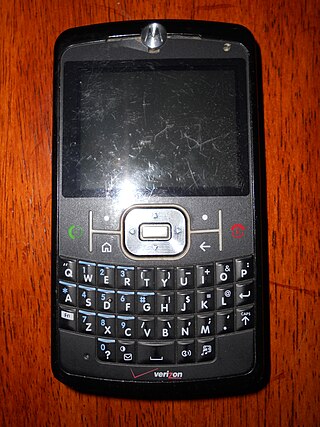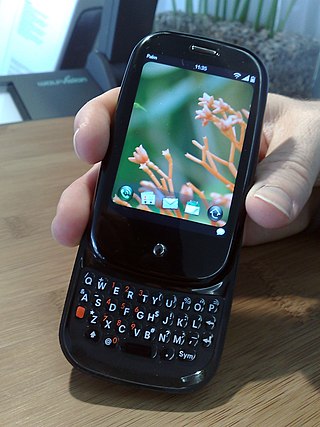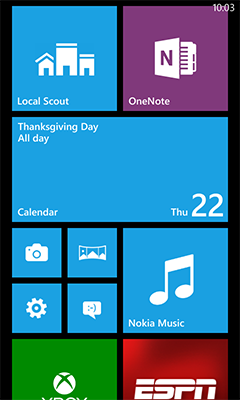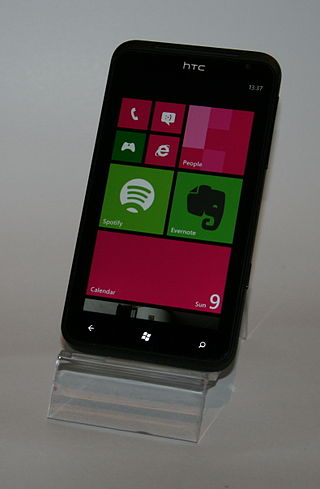Related Research Articles

A personal digital assistant (PDA), also known as a handheld PC, is a multi-purpose mobile device which functions as a personal information manager. PDAs have been mostly displaced by the widespread adoption of highly capable smartphones, in particular those based on iOS and Android, and thus saw a rapid decline in use after 2007.

Microsoft Outlook is a personal information manager software system from Microsoft, available as a part of the Microsoft 365 software suites. Though primarily being popular as an email client for businesses, Outlook also includes functions such as calendaring, task managing, contact managing, note-taking, journal logging, web browsing, and RSS news aggregation.

Nokia PC Suite is a discontinued software package used to establish an interface between Nokia mobile devices and computers that run the Microsoft Windows operating system. Its first release was in 1997, originally called Nokia Data Suite. It was replaced by Nokia Suite and integrated into the Ovi service suite.

Windows Mobile Device Center is a synchronization software program developed by Microsoft, and the successor to ActiveSync. It is designed to synchronize various content including music, video, contacts, calendar events, web browser favorites, and other files between Windows Mobile devices and the Microsoft Windows operating system.

The Motorola Q9c was a smartphone first released in 2007. Initially released as an upgrade to Motorola's Q Series, the Q9C contained a Windows Mobile 6 operating system, push email and instant messaging capabilities, a 1.3 megapixel camera, stereo sound, as well as Bluetooth and GPS navigation.

The Xperia X1 is a high-end smartphone from Sony Ericsson, and is the first in the manufacturer's Xperia series. The phone was designed and built by Taiwanese OEM HTC. The X1 was first presented at the 2008 Mobile World Congress.

Windows Phone (WP) is a discontinued family of mobile operating systems developed by Microsoft for smartphones as the replacement successor to Windows Mobile and Zune. Windows Phone featured a new user interface derived from the Metro design language. Unlike Windows Mobile, it was primarily aimed at the consumer market rather than the enterprise market.
MobileMe is a discontinued subscription-based collection of online services and software offered by Apple Inc. All services were gradually transitioned to and eventually replaced by the free iCloud, and MobileMe ceased on June 30, 2012, with transfers to iCloud being available until July 31, 2012, or data being available for download until that date, when the site finally closed completely. On that date all data was deleted, and email addresses of accounts not transferred to iCloud were marked as unused.

The Palm Pre, styled as palm prē, is a multitasking smartphone that was designed and marketed by Palm with a multi-touch screen and a sliding keyboard. The smartphone was the first to use Palm's Linux-based mobile operating system, webOS. The Pre functions as a camera phone and a portable media player, and has location and navigation capabilities. The Pre also serves as a personal information manager, has a number of communication and collaboration applications, and has Bluetooth and Wi-Fi connectivity built-in.

Samsung GT-i8910 Omnia HD is a smartphone manufactured by Samsung Electronics, first announced at MWC 2009 on February 18, 2009. The device was the first phone capable of playing and recording 720p HD video. It runs on the S60 5th Edition (Symbian^1) platform, the only Samsung device to do so.
The Samsung SGH-i907, marketed as the Samsung Epix in the United States by AT&T Wireless, is a Windows Mobile-based quad-band GSM smartphone manufactured by Samsung.

Kin was a short-lived mobile phone line from Microsoft designed for users of social networking. The phones, aimed at people between ages 15 and 30, were manufactured by Sharp Corporation and sold through Verizon Wireless.
The LG Incite is an Internet-enabled Windows Mobile Pocket PC smartphone designed and marketed by LG of Korea.
Windows Mobile 6.5 was a stopgap update to Windows Mobile 6.1 intended to bridge the gap between version 6.1, that arrived in 2008, and Windows Phone 7 that was released in 2010.

The HTC 7 Surround is a smartphone created by HTC running on the Windows Phone 7 operating system. The HTC Surround launched on November 8, 2010 on AT&T.
This page provides details for the version history of the Microsoft's Windows Phone branded mobile operating systems, from the release of Windows Phone 7 in October 2010, which was preceded by Windows Mobile version 6.x.

Windows Phone 8 is the second generation of the Windows Phone mobile operating system from Microsoft. It was released on October 29, 2012, and, like its predecessor, it features a flat user interface based on the Metro design language. It was succeeded by Windows Phone 8.1, which was unveiled on April 2, 2014.

Windows Phone 7 is the first release of the Windows Phone mobile client operating system, released worldwide on October 21, 2010, and in the United States on November 8, 2010. It runs on the Windows CE 6.0 kernel.

Windows Phone 8.1 is the third generation of Microsoft's Windows Phone mobile operating system, succeeding Windows Phone 8. Rolled out at Microsoft's Build Conference in San Francisco, California, on April 2, 2014, it was released in final form to Windows Phone developers on April 14, 2014 and reached general availability on August 4, 2014. All Windows Phones running Windows Phone 8 can be upgraded to Windows Phone 8.1, with release dependent on carrier rollout dates.
References
- ↑ Damian Koh (2010-02-18). "Q&A: Microsoft on Windows Phone 7". CNET Asia. Archived from the original on 2010-02-21. Retrieved 2010-06-03.
- ↑ "Microsoft talks Windows Phone 7 Series development ahead of GDC: Silverlight, XNA, and no backward compatibility". Engadget.com. 5 March 2010. Retrieved 2011-10-27.
- 1 2 Peter Bright (16 November 2010). "Windows Phone 7: The 10 features Microsoft should add ASAP". Ars Technica .
- ↑ Lein, Adam Z. (February 25, 2011). "How to Sync Windows Phone 7 with Outlook". Pocketnow. Archived from the original on June 27, 2013. Retrieved October 27, 2011.
- ↑ "Win phone 7 Outlook 2010 Sync with stand alone PC". Microsoft Answers. Microsoft. September 6, 2011. Retrieved October 27, 2011.
- ↑ "File management where did it go? What no Windows Explorer? No". Microsoft Answers. Microsoft. September 6, 2011. Retrieved October 27, 2011.
- ↑ "Is there a non-cloud way to sync Windows Phone 7 with Outlook?". Microsoft Answers. Microsoft. June 20, 2012. Retrieved November 1, 2012.
- ↑ "Is Windows Phone 7 going to support direct sync with standalone Outlook?". Microsoft Answers. Microsoft. July 22, 2012. Retrieved November 1, 2012.
- ↑ "Petition Microsoft to reinstate usb sync for Outlook". Microsoft Answers. Microsoft. September 6, 2011. Retrieved October 27, 2011.
- ↑ "No Flash for Windows Phone as Adobe kills off mobile development". Archived from the original on 2015-01-25. Retrieved 2012-03-03.
- 1 2 "Voxofon: hybrid VOIP for Windows Phone 7". wpcentral. 3 June 2010. Archived from the original on 29 December 2012. Retrieved 2 March 2012.
- ↑ Vincent Nguyen (19 July 2010). "Windows Phone 7 Technical Preview". SlashGear.
- ↑ Exclusive interview with Joe Belfiore, corporate VP of Windows Phone. Engadget. 19 July 2010. Event occurs at 06:30.
Actually, as a general matter, there are a whole lot of companies that we're working with pretty closely to figure out what additional capabilities developers want and need to add great new scenarios, and so multitasking is a good example of one we're already talking to people about, we're looking for the right way to implement it. So that's something you'll see come from us at some point.
- ↑ "Hidden SSID Support in Windows Phone 7.5". Archived from the original on 2015-11-06. Retrieved 2012-03-02.
- 1 2 "Windows Phone 7 smartphones can't connect to hidden WiFi networks". Fierce Wireless. 17 October 2010. Archived from the original on 27 February 2013. Retrieved 2 March 2012.
- ↑ "Connecting to a WiFi Network". Microsoft. Retrieved 22 May 2012.
- ↑ Ziegler, Chris (24 September 2010). "Microsoft: Windows Phone 7 doesn't support tethering". Engadget. Retrieved 25 September 2010.
- ↑ Savov, Vlad (11 November 2010). "Windows Phone 7 USB tethering uncovered on Samsung phones". Engadget. Retrieved 21 November 2010.
- ↑ Tethering can be done in WP7 via a hack on the Samsung Focus [18]
- ↑ "Share Your Windows Phone Internet Connection Using The Tethering Feature". makeuseof.com. 24 December 2011. Retrieved 3 March 2012.
- ↑ "No custom ringtones allowed on Windows Phone 7". The Next Web. 26 October 2010.
- ↑ "Windows Phone 7.5: Linked Inbox for Email Consolidation". WinSuperSite. Archived from the original on 26 February 2012. Retrieved 4 March 2012.
- ↑ Андрей Крупин (2 November 2010). "Windows Phone 7: в поисках индивидуальности" [Windows Phone 7: In search of identity] (in Russian). 3DNews Daily Digital Digest . Retrieved 21 November 2010.
... в Windows Phone 7 отсутствует поддержка USSD-запросов ...
- ↑ Made possible through additional apps such as Skype.
- 1 2 "During Microsoft's Windows Phone Summit Microsoft revealed that the OS will support removable memory cards". Archived from the original on 2014-11-13. Retrieved 2012-08-15.
- ↑ Brandon Miniman. "Windows Phone 7 DOES Support Removable Storage: Proof". pocketnow. Archived from the original on 2013-02-12. Retrieved 2012-03-02.
- ↑ "Windows Phone 7 and removable storage". Windows Phone Secrets.
- ↑ Windows Phone 7 supports upgradable storage via an SD card; however SD card memory is merged with the phone's internal storage, and changing the SD card causes the phone to reset to factory settings [26] [27]
- ↑ Bonnie Cha (27 October 2010). "Top 5 things I dislike about Windows Phone 7". CNET .
- 1 2 "Windows Phone 7 OS review: From scratch". GSM Arena. 8 October 2010.
- ↑ VOIP calls will look just like regular phone calls with all the same features and notifications.
- ↑ "Windows Phone 7 misses big-business support tools". The Register . 26 July 2010.
- ↑ Galen Gruman (8 November 2010). "Windows Phone 7 lacks on-device encryption". InfoWorld .
- ↑ Paul Thurrott (19 October 2010). "Windows Phone 7 in the Enterprise?". WindowsITPro. Archived from the original on 5 January 2013.
- ↑ Microsoft brings true, background multitasking to Windows Phone 8
- ↑ Seamless voice-to-video call switching with LTE: "... the only Android phones that support UMTS video calls are the Samsung Galaxy series of phones. Other than that, only Symbian and Windows Mobile (not Windows Phone) phones support UMTS video calls."